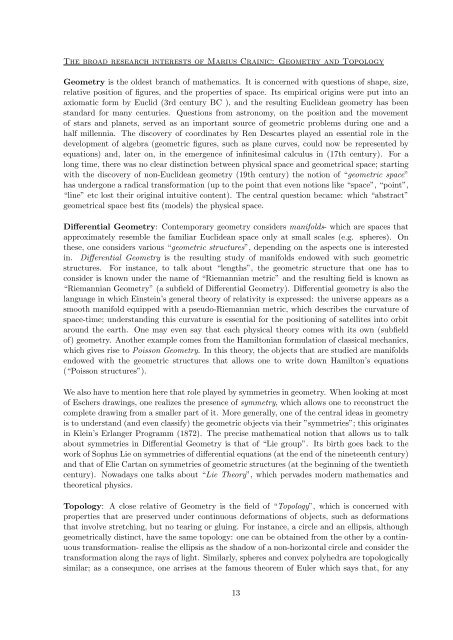Curriculum Vitae for Marius Crainic
Curriculum Vitae for Marius Crainic
Curriculum Vitae for Marius Crainic
Create successful ePaper yourself
Turn your PDF publications into a flip-book with our unique Google optimized e-Paper software.
The broad research interests of <strong>Marius</strong> <strong>Crainic</strong>: Geometry and Topology<br />
Geometry is the oldest branch of mathematics. It is concerned with questions of shape, size,<br />
relative position of figures, and the properties of space. Its empirical origins were put into an<br />
axiomatic <strong>for</strong>m by Euclid (3rd century BC ), and the resulting Euclidean geometry has been<br />
standard <strong>for</strong> many centuries. Questions from astronomy, on the position and the movement<br />
of stars and planets, served as an important source of geometric problems during one and a<br />
half millennia. The discovery of coordinates by Ren Descartes played an essential role in the<br />
development of algebra (geometric figures, such as plane curves, could now be represented by<br />
equations) and, later on, in the emergence of infinitesimal calculus in (17th century). For a<br />
long time, there was no clear distinction between physical space and geometrical space; starting<br />
with the discovery of non-Euclidean geometry (19th century) the notion of “geometric space”<br />
has undergone a radical trans<strong>for</strong>mation (up to the point that even notions like “space”, “point”,<br />
“line” etc lost their original intuitive content). The central question became: which “abstract”<br />
geometrical space best fits (models) the physical space.<br />
Differential Geometry: Contemporary geometry considers manifolds- which are spaces that<br />
approximately resemble the familiar Euclidean space only at small scales (e.g. spheres). On<br />
these, one considers various “geometric structures”, depending on the aspects one is interested<br />
in. Differential Geometry is the resulting study of manifolds endowed with such geometric<br />
structures. For instance, to talk about “lengths”, the geometric structure that one has to<br />
consider is known under the name of “Riemannian metric” and the resulting field is known as<br />
“Riemannian Geometry” (a subfield of Differential Geometry). Differential geometry is also the<br />
language in which Einstein’s general theory of relativity is expressed: the universe appears as a<br />
smooth manifold equipped with a pseudo-Riemannian metric, which describes the curvature of<br />
space-time; understanding this curvature is essential <strong>for</strong> the positioning of satellites into orbit<br />
around the earth. One may even say that each physical theory comes with its own (subfield<br />
of) geometry. Another example comes from the Hamiltonian <strong>for</strong>mulation of classical mechanics,<br />
which gives rise to Poisson Geometry. In this theory, the objects that are studied are manifolds<br />
endowed with the geometric structures that allows one to write down Hamilton’s equations<br />
(“Poisson structures”).<br />
We also have to mention here that role played by symmetries in geometry. When looking at most<br />
of Eschers drawings, one realizes the presence of symmetry, which allows one to reconstruct the<br />
complete drawing from a smaller part of it. More generally, one of the central ideas in geometry<br />
is to understand (and even classify) the geometric objects via their ”symmetries”; this originates<br />
in Klein’s Erlanger Programm (1872). The precise mathematical notion that allows us to talk<br />
about symmetries in Differential Geometry is that of “Lie group”. Its birth goes back to the<br />
work of Sophus Lie on symmetries of differential equations (at the end of the nineteenth century)<br />
and that of Elie Cartan on symmetries of geometric structures (at the beginning of the twentieth<br />
century). Nowadays one talks about “Lie Theory”, which pervades modern mathematics and<br />
theoretical physics.<br />
Topology: A close relative of Geometry is the field of “Topology”, which is concerned with<br />
properties that are preserved under continuous de<strong>for</strong>mations of objects, such as de<strong>for</strong>mations<br />
that involve stretching, but no tearing or gluing. For instance, a circle and an ellipsis, although<br />
geometrically distinct, have the same topology: one can be obtained from the other by a continuous<br />
trans<strong>for</strong>mation- realise the ellipsis as the shadow of a non-horizontal circle and consider the<br />
trans<strong>for</strong>mation along the rays of light. Similarly, spheres and convex polyhedra are topologically<br />
similar; as a consequnce, one arrises at the famous theorem of Euler which says that, <strong>for</strong> any<br />
13

















